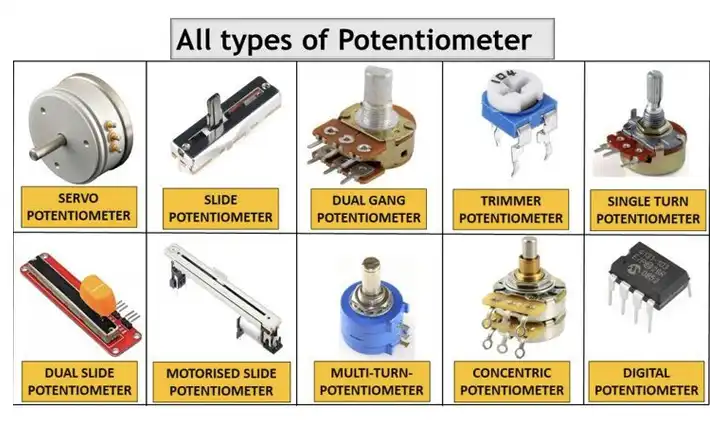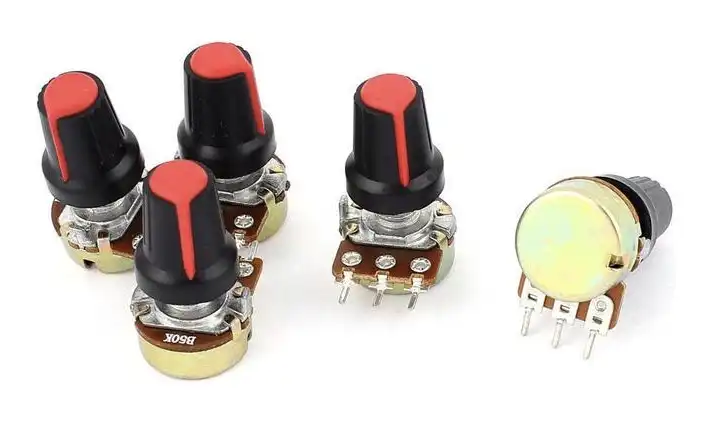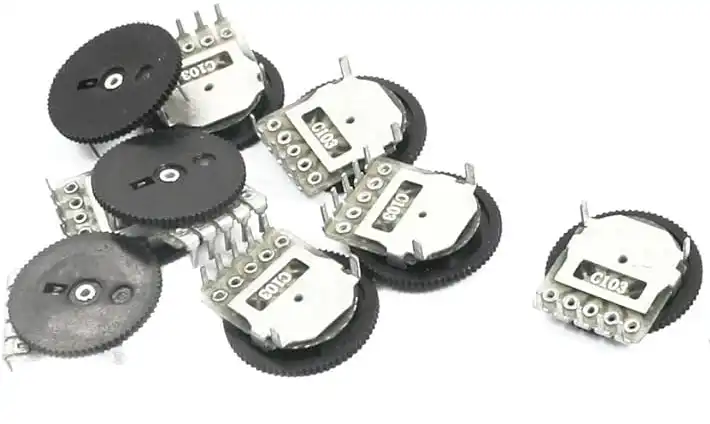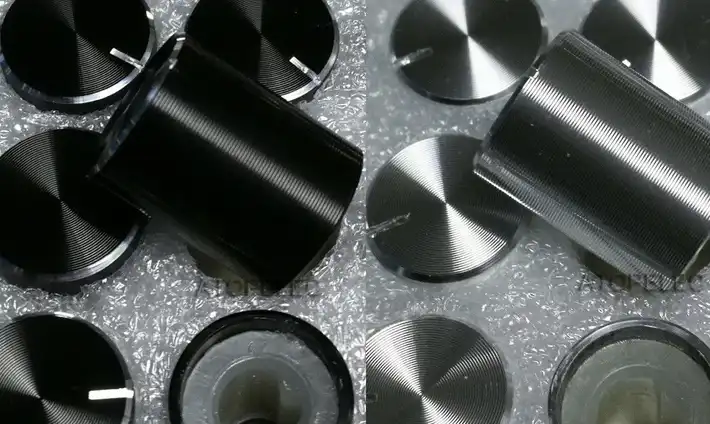Potentiometers, often referred to as “pots,” are a staple in the world of electronics. These humble components serve a crucial role in controlling voltage and resistance in a circuit. But did you know there are several different types of potentiometers, each with its unique characteristics and applications?
Let’s delve into the world of potentiometers and explore the different types.
Potentiometer Types

1. Rotary Potentiometer
The most common type of potentiometer is the rotary potentiometer. As the name suggests, this potentiometer operates through a rotating mechanism. When you turn the knob, you’re moving a wiper across a circular resistive track, varying the resistance. Rotary potentiometers are commonly used in audio equipment for volume control, tuning knobs in radios, and in any application where a dial-like interface is suitable.
2. Linear Potentiometer
While rotary potentiometers use a circular motion, linear potentiometers, also known as slide potentiometers, operate by sliding a wiper back and forth along a straight resistive track. This linear movement can provide a more intuitive interface for controlling levels or positions. They are often used in sound mixing desks, lighting control boards, and car audio systems.
3. Dual-Gang Potentiometer
A dual-gang potentiometer is essentially two potentiometers in one. It has two separate pots mounted on the same shaft, allowing them to be controlled simultaneously by a single knob. This type is often used in stereo audio systems, where one pot controls the left channel and the other controls the right channel, ensuring the volume changes are identical for both.
4. Multi-Turn Potentiometer
A multi-turn potentiometer, as the name suggests, requires multiple turns of the control knob to move the wiper from one end of the track to the other. This allows for more precise control of the resistance. These are commonly used in devices that require high precision, such as in laboratory equipment and precision tuning circuits.
5. Digital Potentiometer
A digital potentiometer, unlike the other types, is controlled electronically rather than by mechanical movement. It uses digital signals to control the resistance. Digital potentiometers are used in modern electronic devices where adjustments need to be made electronically, such as in digital audio equipment and computerized systems.
6. Motorized Potentiometer
Motorized potentiometers are a type of potentiometer that can be adjusted remotely. They have a motor attached to the shaft, which can be controlled electronically to adjust the position of the wiper. These are commonly used in situations where the potentiometer needs to be adjusted remotely, such as in large sound systems or industrial control systems.
Here’s a table summarizing the different types of potentiometers:
| Potentiometer Type | Description | Common Uses |
|---|---|---|
| B Type (Linear) | Resistance changes linearly as the knob is turned | Applications requiring a consistent, linear change in resistance |
| C Type | Characteristics can vary | Check manufacturer‘s specifications |
| D Type | Characteristics can vary | Often used in guitars, check manufacturer‘s specifications |
| A Type (Logarithmic/Audio) | Resistance changes logarithmically, more sensitive at lower volumes | Commonly used in audio equipment for volume control |
Please note that the characteristics of C and D type potentiometers can vary significantly, so it’s crucial to check the specifications provided by the manufacturer.
B Type Potentiometer

The B type potentiometer, also known as a linear potentiometer, is one of the most common types used. The term “B” comes from the Asian marking method, which uses “B” to denote linear taper. In a B type potentiometer, the resistance changes linearly as the potentiometer’s knob is turned. This means that at the halfway point, the resistance is approximately half of the potentiometer’s total resistance. B type potentiometers are often used in applications where a consistent, linear change in resistance is required.
C Type Potentiometer

The C type potentiometer is less common and isn’t standardized like the A or B types. The prefix “C” does not correspond to a specific taper or characteristic in the same way that A (logarithmic/audio taper) and B (linear taper) do. The characteristics of a C type potentiometer can vary, so it’s important to check the manufacturer‘s specifications.
D Type Potentiometer

The D type potentiometer is also not a standardized type. However, in some contexts, D type pots are used to refer to a specific type of potentiometer used in guitars. According to some guitar enthusiasts, A pots are generally used as tone pots and B’s are used as volume pots, while D pots are a more specialized type. Again, the exact characteristics can vary, so it’s crucial to check the specifications provided by the manufacturer.
Conclusion
In conclusion, while all potentiometers serve the same basic function – to vary resistance in a circuit – the type of potentiometer you choose can impact its functionality and the applications it’s suited for. From the common rotary potentiometer to the precise multi-turn potentiometer, each type has its unique advantages and uses. Understanding these differences can help you choose the right potentiometer for your next electronics project.